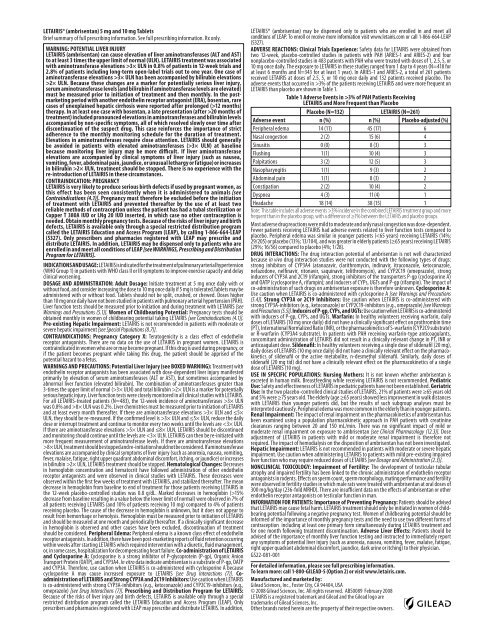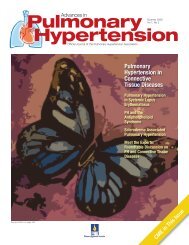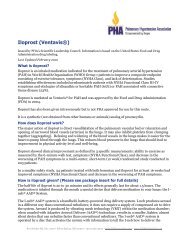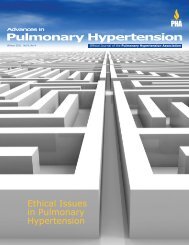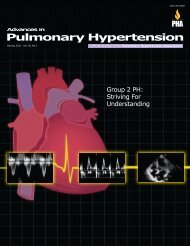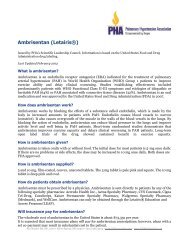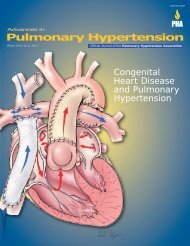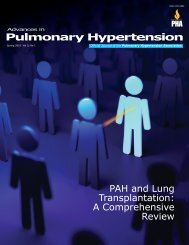Vol 7, No 3 - PHA Online University
Vol 7, No 3 - PHA Online University
Vol 7, No 3 - PHA Online University
Create successful ePaper yourself
Turn your PDF publications into a flip-book with our unique Google optimized e-Paper software.
LETAIRIS® (ambrisentan) 5 mg and 10 mg Tablets<br />
Brief summary of full prescribing information. See full prescribing information. Rx only.<br />
WARNING: POTENTIAL LIVER INJURY<br />
LETAIRIS (ambrisentan) can cause elevation of liver aminotransferases (ALT and AST)<br />
to at least 3 times the upper limit of normal (ULN). LETAIRIS treatment was associated<br />
with aminotransferase elevations >3× ULN in 0.8% of patients in 12-week trials and<br />
2.8% of patients including long-term open-label trials out to one year. One case of<br />
aminotransferase elevations >3× ULN has been accompanied by bilirubin elevations<br />
>2× ULN. Because these changes are a marker for potentially serious liver injury,<br />
serum aminotransferase levels (and bilirubin if aminotransferase levels are elevated)<br />
must be measured prior to initiation of treatment and then monthly. In the postmarketing<br />
period with another endothelin receptor antagonist (ERA), bosentan, rare<br />
cases of unexplained hepatic cirrhosis were reported after prolonged (>12 months)<br />
therapy. In at least one case with bosentan, a late presentation (after >20 months of<br />
treatment) included pronounced elevations in aminotransferases and bilirubin levels<br />
accompanied by non-specific symptoms, all of which resolved slowly over time after<br />
discontinuation of the suspect drug. This case reinforces the importance of strict<br />
adherence to the monthly monitoring schedule for the duration of treatment.<br />
Elevations in aminotransferases require close attention. LETAIRIS should generally<br />
be avoided in patients with elevated aminotransferases (>3× ULN) at baseline<br />
because monitoring liver injury may be more difficult. If liver aminotransferase<br />
elevations are accompanied by clinical symptoms of liver injury (such as nausea,<br />
vomiting, fever, abdominal pain, jaundice, or unusual lethargy or fatigue) or increases<br />
in bilirubin >2× ULN, treatment should be stopped. There is no experience with the<br />
re-introduction of LETAIRIS in these circumstances.<br />
CONTRAINDICATION: PREGNANCY<br />
LETAIRIS is very likely to produce serious birth defects if used by pregnant women, as<br />
this effect has been seen consistently when it is administered to animals [see<br />
Contraindications (4.1)]. Pregnancy must therefore be excluded before the initiation<br />
of treatment with LETAIRIS and prevented thereafter by the use of at least two<br />
reliable methods of contraception unless the patient has had a tubal sterilization or<br />
Copper T 380A IUD or LNg 20 IUD inserted, in which case no other contraception is<br />
needed. Obtain monthly pregnancy tests. Because of the risks of liver injury and birth<br />
defects, LETAIRIS is available only through a special restricted distribution program<br />
called the LETAIRIS Education and Access Program (LEAP), by calling 1-866-664-LEAP<br />
(5327). Only prescribers and pharmacies registered with LEAP may prescribe and<br />
distribute LETAIRIS. In addition, LETAIRIS may be dispensed only to patients who are<br />
enrolled in and meet all conditions of LEAP [see WARNINGS, Prescribing and Distribution<br />
Program for LETAIRIS].<br />
INDICATIONS AND USAGE: LETAIRIS is indicated for the treatment of pulmonar y ar terial hyper tension<br />
(WHO Group 1) in patients with WHO class II or III symptoms to improve exercise capacity and delay<br />
clinical worsening.<br />
DOSAGE AND ADMINISTRATION: Adult Dosage: Initiate treatment at 5 mg once daily with or<br />
without food, and consider increasing the dose to 10 mg once daily if 5 mg is tolerated.Tablets may be<br />
administered with or without food. Tablets should not be split, crushed, or chewed. Doses higher<br />
than 10 mg once daily have not been studied in patients with pulmonary arterial hypertension (PAH).<br />
Liver function tests should be measured prior to initiation and during treatment with LETAIRIS [see<br />
Warnings and Precautions (5.1)]. Women of Childbearing Potential: Pregnancy tests should be<br />
obtained monthly in women of childbearing potential taking LETAIRIS [see Contraindications (4.1)].<br />
Pre-existing Hepatic Impairment: LETAIRIS is not recommended in patients with moderate or<br />
severe hepatic impairment [see Special Populations (8.7)].<br />
CONTRAINDICATIONS: Pregnancy Category X: Teratogenicity is a class effect of endothelin<br />
receptor antagonists. There are no data on the use of LETAIRIS in pregnant women. LETAIRIS is<br />
contraindicated in women who are or may become pregnant. If this drug is used during pregnancy, or<br />
if the patient becomes pregnant while taking this drug, the patient should be apprised of the<br />
potential hazard to a fetus.<br />
WARNINGS AND PRECAUTIONS: Potential Liver Injury (see BOXED WARNING): Treatment with<br />
endothelin receptor antagonists has been associated with dose-dependent liver injury manifested<br />
primarily by elevation of serum aminotransferases (ALT or AST), but sometimes accompanied by<br />
abnormal liver function (elevated bilirubin). The combination of aminotransferases greater than<br />
3-times the upper limit of normal (>3× ULN) and total bilirubin >2× ULN is a marker for potentially<br />
serious hepatic injury. Liver function tests were closely monitored in all clinical studies with LETAIRIS.<br />
For all LETAIRIS-treated patients (N=483), the 12-week incidence of aminotransferases >3× ULN<br />
was 0.8% and >8× ULN was 0.2%. Liver chemistries must be measured prior to initiation of LETAIRIS<br />
and at least every month thereafter. If there are aminotransferase elevations >3× ULN and ≤5×<br />
ULN, they should be re-measured. If the confirmed level is >3× ULN and ≤5× ULN, reduce the daily<br />
dose or interrupt treatment and continue to monitor every two weeks until the levels are 5× ULN and ≤8× ULN, LETAIRIS should be discontinued<br />
and monitoring should continue until the levels are 8× ULN, treatment should be stopped and re-initiation should not be considered. If aminotransferase<br />
elevations are accompanied by clinical symptoms of liver injury (such as anorexia, nausea, vomiting,<br />
fever, malaise, fatigue, right upper quadrant abdominal discomfort, itching, or jaundice) or increases<br />
in bilirubin >2× ULN, LETAIRIS treatment should be stopped. Hematological Changes: Decreases<br />
in hemoglobin concentration and hematocrit have followed administration of other endothelin<br />
receptor antagonists and were observed in clinical studies with LETAIRIS. These decreases were<br />
observed within the first few weeks of treatment with LETAIRIS, and stabilized thereafter. The mean<br />
decrease in hemoglobin from baseline to end of treatment for those patients receiving LETAIRIS in<br />
the 12-week placebo-controlled studies was 0.8 g/dL. Marked decreases in hemoglobin (>15%<br />
decrease from baseline resulting in a value below the lower limit of normal) were observed in 7% of<br />
all patients receiving LETAIRIS (and 10% of patients receiving 10 mg) compared to 4% of patients<br />
receiving placebo. The cause of the decrease in hemoglobin is unknown, but it does not appear to<br />
result from hemorrhage or hemolysis. Hemoglobin must be measured prior to initiation of LETAIRIS<br />
and should be measured at one month and periodically thereafter. If a clinically significant decrease<br />
in hemoglobin is observed and other causes have been excluded, discontinuation of treatment<br />
should be considered. Peripheral Edema: Peripheral edema is a known class effect of endothelin<br />
receptor antagonists. In addition, there have been post-marketing reports of fluid retention occurring<br />
within weeks after starting LETAIRIS which required intervention with a diuretic, fluid management,<br />
or, in some cases, hospitalization for decompensating heart failure. Co-administration of LETAIRIS<br />
and Cyclosporine A: Cyclosporine is a strong inhibitor of P-glycoprotein (P-gp), Organic Anion<br />
Transport Protein (OATP), and CYP3A4. In vitro data indicate ambrisentan is a substrate of P-gp, OATP<br />
and CYP3A. Therefore, use caution when LETAIRIS is co-administered with cyclosporine A because<br />
cyclosporine A may cause increased exposure to LETAIRIS [see Drug Interactions (7)]. Coadministration<br />
of LETAIRIS and Strong CYP3A and 2C19 Inhibitors: Use caution when LETAIRIS<br />
is co-administered with strong CYP3A-inhibitors (e.g., ketoconazole) and CYP2C19-inhibitors (e.g.,<br />
omeprazole) [see Drug Interactions (7)]. Prescribing and Distribution Program for LETAIRIS:<br />
Because of the risks of liver injury and birth defects, LETAIRIS is available only through a special<br />
restricted distribution program called the LETAIRIS Education and Access Program (LEAP). Only<br />
prescribers and pharmacies registered with LEAP may prescribe and distribute LETAIRIS. In addition,<br />
LETAIRIS® (ambrisentan) may be dispensed only to patients who are enrolled in and meet all<br />
conditions of LEAP. To enroll or receive more information visit www.letairis.com or call 1-866-664-LEAP<br />
(5327).<br />
ADVERSE REACTIONS: Clinical Trials Experience: Safety data for LETAIRIS were obtained from<br />
two 12-week, placebo-controlled studies in patients with PAH (ARIES-1 and ARIES-2) and four<br />
nonplacebo-controlled studies in 483 patients with PAH who were treated with doses of 1, 2.5, 5, or<br />
10 mg once daily. The exposure to LETAIRIS in these studies ranged from 1 day to 4 years (N=418 for<br />
at least 6 months and N=343 for at least 1 year). In ARIES-1 and ARIES-2, a total of 261 patients<br />
received LETAIRIS at doses of 2.5, 5, or 10 mg once daily and 132 patients received placebo. The<br />
adverse events that occurred in >3% of the patients receiving LETAIRIS and were more frequent on<br />
LETAIRIS than placebo are shown in Table 1.<br />
Table 1 Adverse Events in >3% of PAH Patients Receiving<br />
LETAIRIS and More Frequent than Placebo<br />
Placebo (N=132)<br />
LETAIRIS (N=261)<br />
Adverse event n (%) n (%) Placebo-adjusted (%)<br />
Peripheral edema 14 (11) 45 (17) 6<br />
Nasal congestion 2 (2) 15 (6) 4<br />
Sinusitis 0 (0) 8 (3) 3<br />
Flushing 1 (1) 10 (4) 3<br />
Palpitations 3 (2) 12 (5) 3<br />
Nasopharyngitis 1 (1) 9 (3) 2<br />
Abdominal pain 1 (1) 8 (3) 2<br />
Constipation 2 (2) 10 (4) 2<br />
Dyspnea 4 (3) 11 (4) 1<br />
Headache 18 (14) 38 (15) 1<br />
<strong>No</strong>te: This table includes all adverse events >3% incidence in the combined LETAIRIS treatment group and more<br />
frequent than in the placebo group, with a difference of ≥1% between the LETAIRIS and placebo groups.<br />
Most adverse drug reactions were mild to moderate and only nasal congestion was dose-dependent.<br />
Fewer patients receiving LETAIRIS had adverse events related to liver function tests compared to<br />
placebo. Peripheral edema was similar in younger patients (


